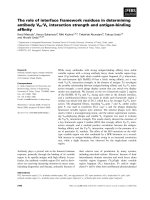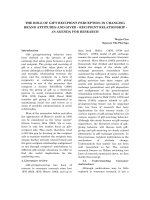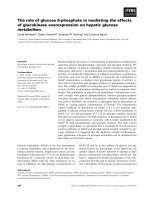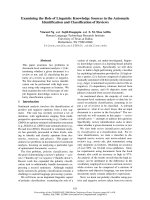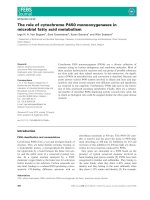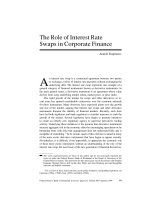The role of serum amyloid A1(SAA1) in coronary artery disease
Bạn đang xem bản rút gọn của tài liệu. Xem và tải ngay bản đầy đủ của tài liệu tại đây (1.15 MB, 205 trang )
THE ROLE OF SERUM AMYLOID A1 (SAA1)
IN CORONARY ARTERY DISEASE
LEOW KOON YEOW
BSc (Hons), NUS
A THESIS SUBMITTED
FOR THE DEGREE OF DOCTOR OF PHILOSOPHY
DEPARTMENT OF PAEDIATRICS
NATIONAL UNIVERSITY OF SINGAPORE
2011
i
Acknowledgments
I would like to convey my sincere appreciation to my supervisor A/P Heng Chew Kiat for
his patient guidance and advices throughout the years. Special thanks also go to my fellow
colleagues and ex-colleagues Lee Siang Ling Karen, Lye Hui Jen, Larry Poh, Zhao Yulan,
Zhou Shuli, Yang Ennan, Li Hongzhe, Goh June Mui and Tan Si Zhen for their ever
enthusiastic help and advices rendered. My deepest gratification is also extended to the staff
of the immunology divison of the Department of Paediatrics for their selfless sharing of
both technical knowledge and research facilities. Last but not least, I am indebted to my
dearest family and friends who have made those difficult moments more bearable. This
research was supported by the research grant offered by National Medical Research Council,
Singapore (NMRC/1155/2008).
ii
TABLE OF CONTENTS
SUMMARY xi
LIST OF TABLES xiii
LIST OF FIGURES xv
LIST OF SYMBOLS xvii
1 INTRODUCTION
1.1 Brief background 1
1.2 Thesis objectives 1
1.3 Thesis organization 2
2 LITERATURE REVIEW
2.1 Atherosclerosis and coronary artery disease (CAD) 3
2.1.1 Atherosclerosis – a chronic inflammatory disease
2.1.2 Pathogenesis of atherosclerosis and acute coronary syndrome
2.1.3 Risk factors for CAD
2.1.4 Existing drugs treatment for CAD
2.1.4.1 Statins
2.1.5 Potential treatment strategies for CAD
2.2 Serum Amyloid A (SAA) 12
2.2.1 SAAs gene and protein family
2.2.2 The acute phase response (APR)
2.2.3 Protein structure and functional domains of SAA1
iii
2.2.4 Production of A-SAA and the role of perivascular adipocytes
in CAD
2.2.5 Regulation of expression of A-SAA
2.2.6 Surface receptors of A-SAA
2.2.7 A-SAA as a clinical biomarker
2.2.8 Atherogenic effects of A-SAA
2.2.9 Atheroprotective effects of A-SAA
2.2.10 Role of A-SAA in other chronic inflammatory diseases
2.3 Genetic Analysis of Complex Diseases 24
2.3.1 Complex Diseases
2.3.2 Genetic variation and SNPs
2.3.3 Methods for genetic analysis of human diseases
2.3.3.1 Parametric linkage analysis
2.3.3.2 Non-parametric linkage analysis
2.3.3.3 Genetic association study
2.3.4 Mutation screening
2.3.4.1 Denaturating gradient gel electrophoresis (DGGE)
2.3.4.2 Denaturing high performance liquid chromatography (DHPLC)
2.3.4.3 High resolution melting (HRM)
2.3.4.4 Single-strand conformation polymorphism (SCCP)
2.3.4.5 Choice of method for mutant screening
2.3.5 Methods of SNP genotyping
2.3.5.1 Allele-specific PCR
2.3.5.2 Restriction fragment length polymorphism (RFLP)
2.3.5.3 HRM
iv
2.3.5.4 Primer extension
2.3.5.5 Hybridisation probes
2.3.5.6 Selection of method for SNP genotyping
3 MATERIALS AND METHODS
3.1 SAA1 SNPs survey 37
3.1.1 Study subjects
3.1.2 DNA extraction
3.1.3 Primer design and PCR amplification
3.1.4 High-resolution melting and automatic calling
3.1.5 DNA sequencing
3.1.6 In silico SNP discovery and in silico prediction of biological
significance of polymorphisms
3.2 Genetic association study 42
3.2.1 Study subjects
3.2.2 Genotyping by allele-specific PCR
3.2.3 Genotyping by RFLP
3.2.4 Data analysis
3.3 Functional study of p.Gly90Asp 44
3.3.1 Preparation of recombinant human SAA1
3.3.1.1 Plasmid construction
3.3.1.2 Production of wild-type and variant human SAA1 protein
3.3.1.3 Purification of recombinant SAA
3.3.1.4 Endotoxin removal and detection
3.3.1.5 Concentration and quantification of protein
v
3.3.2 Cell culture of macrophages and neutrophils
3.3.3 Measurement of cytokines release from macrophages and
neutrophils
3.3.4 Neutral cholesteryl ester hydrolase (nCEH) activity assay
3.3.5 Data analysis
3.4 Microarray Study 49
3.4.1 Cell culture
3.4.2 RNA isolation and cRNA synthesis
3.4.3 Array hybridization and scanning
3.4.4 Quantitative real-time PCR validation of microarray results
3.4.5 Data analysis
3.5 Elucidation of surface receptors of SAA1 54
3.5.1 Cell culture
3.5.2 Data analysis
4 SAA1 SNP
S
SURVEY
4.1 Introduction 56
4.2 Results 57
4.2.1 SNPfinder analysis of deposited Unigene Expressed Sequence
Tags (ESTs)
4.2.2 SNPs survey using deposited data in dbSNP
4.2.3 Variant screening of promoter and exons of SAA1
4.3 Discussion 69
4.3.1 SNPs survey using in silico SNPFINDER and dbSNP
4.3.2 SNPs survey by the method of HRM
vi
4.3.3 Significance of variant screening of SAA1
4.3.4 Caveats of SNP survey
5 ASSOCIATION STUDY OF
SAA1
SNPS IN SINGAPOREAN CHINESE
POPULATION
5.1 Introduction 75
5.2 Results 79
5.2.1 Population demographics
5.2.2 Single locus case control association study of c 913G>A, c 637C>T,
c.209C>T (p.Ala70Val) and c.224C>T (p.Ala75Val)
5.2.2.1 Genotyping of c 913G>A, c 637C>T, c.209C>T and c.224C>T
5.2.2.2 Genotype and allele frequency
5.2.2.3 Odds ratio of c 637C>T, c.209C>T and c.224C>T as analysed
using different genetic models
5.2.3 Single locus case control association study of c.269G>A
5.2.4 Genotyping results of the 5 SNPs after adjustment for age, gender and
BMI
5.2.5 Sample size determination for the various SNPs
5.3 Discussion 89
5.3.1 Choice of SNPs for genotyping and genotyping methods
5.3.2 Genotyping results of c 913G>A, c 637C>T, c.209C>T and c.224C>T
5.3.3 Genotyping result of -269G>A and significance of results of
genetic association study
5.3.4 Caveats of genetic association study
5.3.5 Future works
vii
6 FUNCTIONAL STUDY OF p.Gly90Asp
6.1 Introduction 96
6.2 Results 98
6.2.1 Production of IL-8, TNF-α and MCP-1 from THP-1 macrophages
6.2.2 Production of IL-8 and MCP-1 from neutrophils like
differentiated HL-60 cells
6.2.3 Effects of SAA on nCEH activity
6.2.4 Microarray studies of wild-type SAA1 (Gly90) and variant SAA1
(Asp90) in THP-1-derived macrophages
6.2.4.1 Differential gene expression between wild-type SAA1
and variant SAA1 at 8 h
6.2.4.2 Differential gene expression between wild-type SAA1
and variant SAA1 at 24 h
6.2.4.3 Real-time PCR validation of microarray result
6.3 Discussion 108
6.3.1 Effects of SAA1 treatment on cytokine production in macrophages
and neutrophils
6.3.2 Effects of SAA1 treatment on cholesterol storage and metabolism
6.3.3 Differential effects of wild-type and variant SAA1 on global
expression level in macrophages
6.3.4 Intrepretation of results of the functional assays
6.3.5 Caveats of functional characterization of p.Gly90Asp
6.3.6 Future works
viii
7 GENETIC EXPRESSION PROFILING OF THP-1 DERIVED
MACROPHAGES UPON TREATMENT WITH SAA1
7.1 Introduction 117
7.2 Results 118
7.2.1 Microarray analysis
7.2.1.1 Quality of microarray data
7.2.1.2 Effects of SAA1 on gene expression in THP-1 derived
macrophages at 8 h
7.2.1.2.1 Differentially expressed genes involved in angiogenesis
7.2.1.2.2 Differentially expressed genes involved in apoptotic process
7.2.1.2.3 Differentially expressed genes involved in inflammatory
processes
7.2.1.2.4 Differentially expressed genes involved in phagocytosis
7.2.1.2.5 Differentially expressed genes with possible role in tissue
remodeling/wound healing
7.2.1.3 Effects of SAA1 on gene expression in THP-1 derived
macrophages at 24 h
7.2.1.4 Enriched pathways upon treatment with SAA1 at 8 h
7.2.2 Validation of microarray results using real-time PCR
7.2.3 Effects of SAA1 on chemokines production
7.2.4 Surface receptors of SAA1
7.3 Discussion 135
7.3.1 Effects of SAA1 on gene expression profile in THP-1 derived
macrophages
7.3.2 Cell-surface receptors of SAA1
7.3.3 Future works
ix
8 CONCLUSION AND FUTURE WORKS 141
BIBLIOGRAPHY 144
x
APPENDICES
APPENDIX 6-1 Differential gene expression in THP-1 macrophages 176
upon treatment with either wild-type or variant SAA1
for 24 h
APPENDIX 6-2 Raw data for real-time PCR
178
APPENDIX 6-3 ELISA raw data for the quantification of cytokines secreted 180
by macrophages upon induction by either wild-type SAA1
or variant SAA1
APPENDIX 6-4 Raw data for microarray 181
APPENDIX 7-1 Upregulated genes upon wild-type SAA1 treatment at 8 182
hr
APPENDIX 7-2 ELISA raw data for the quantification of chemokines upon 184
treatment with SAA1
APPENDIX 7-3 ELISA raw data for the quantification of cytokines upon 185
antibody and SAA1 treatment
xi
SUMMARY
Background:
Atherosclerosis is a gradual narrowing of the lumen of the arteries and chronic inflammation
has long being regarded as crucial to the pathogenesis of the disease. Serum amyloid A1
(SAA1) and serum amyloid A2 (SAA2) (A-SAA) are acute-phase proteins (APPs); the
concentration of A-SAA can increase by 500-1000 fold during an acute systemic
inflammation (Malle et al. 1993). The predominant form of A-SAA in plasma is reported to
be SAA1 (Yamada et al. 1999). A-SAA has increasingly been associated with atherosclerosis
(Johnson et al. 2004; Ogasawara et al. 2004; Ridker et al. 2000), this stem from its immune
regulatory role as well as the inflammatory nature of atherosclerosis. However, its specific
role in atherosclerosis, in particular, whether it is atherogenic or atheroprotective remains
unknown. In addition, no prior genetic epidemiology study has been conducted on SAA1.
Methods and results:
Genetic variant screening was performed using cord blood DNA samples from 96
anonymous, unrelated Singaporean Chinese neonates delivered in the National University
Hospital, Singapore. Genetic association study was performed using DNA samples extracted
from blood samples belonging to coronary artery disease (CAD) patients. In total, there were
1243 healthy controls and 800 CAD patients. Healthy controls were recruited from subjects
attending a routine health screening. Functional characterization of the genetic variant,
p.Gly90Asp, was performed in vitro using human THP-1 derived macrophages.
In total, 6 genetic variants were identified in the exons and promoter of SAA1, of which 2
are novel - c 913G>A and c.92-5T>G. The non-conservative genetic variant, p.Gly90Asp
(c.269G>A), is not associated with CAD, the odds ratio is 1.61 (95% confidence interval
xii
(CI) 0.68-3.80; P-value =0.28) after adjustment for age, gender and BMI. In addition, the
variant, p.Gly90Asp also induced a significantly lower level of inflammatory cytokines in
THP-1 derived macrophages, the decrease in IL-8, MCP-1 and TNF-α secreted were 57%,
50% and 39% respectively. Variant SAA1 also has a lower impact on the genetic expression
level of a potentially atheroprotective gene, plasminogen activator inhibitor-2 precurosor
(SERPINB2), the expression ratio of wild-type SAA1 to variant SAA1 is 1.8 (95%
confidence interval (CI) 1.3-2.4; P-value < 0.0001). Microarray study also suggests an
atherogenic role of SAA1 with the induction of genes that are involved in inflammation,
angiogenesis, phagocytosis and tissue remodeling; these processes are crucial to the
development of atherosclerotic lesion.
Conclusions:
The identification of a genetic mutant of SAA1, p.Gly90Asp that is associated with CAD
supports the hypothesis that SAA1 has a direct role to play in the pathogenesis of CAD.
p.Gly90Asp has altered functional effects and induces a lower extent of cytokine secretion in
macrophages and potentially atheroprotective SERPINB2, the latter could account for the
increased susceptibility of p.Gly90Asp to CAD. The alter effects of the mutant is probably
due to the lower affinity of the genetic variant to cell surface receptors of SAA1 such as
TLR2 and CLA-1. Lastly, SAA1 regulates expression of genes with functional roles in key
processes of atherosclerosis; it thus plays a direct role in CAD and does not act as a mere
marker of chronic inflammatory diseases.
xiii
LIST OF TABLES
Table 2-1 Deleterious and protective risk factors for acute myocardial 5
infarction
Table 2-2 Pleiotropic effects observed with statin treatment 8
Table 2-3 Potential anti-atherosclerosis drugs in various stages of 10
clinical trials
Table 2-4 Reported surface receptors of A-SAA 19
Table 2-5 Comparison of the various methods for genetic variant screening 31
Table 2-6 Comparison of the various methods for SNP genotyping 36
Table 3-1 Primer sequences for amplification of selected regions of SAA1 39
Table 3-2 Primer sequences for real-time PCR 51
Table 4-1 List of predicted SAA1 SNPs by SNPFINDER. 57
Table 4-2 List of SAA1 SNPs obtained from a manual search of dbSNP 62
Table 4-3 Non-synonymous and non-conservative amino acid changes 63
predicted by SNPfinder and dbSNP
Table 4-4 Polymorphisms identified in the exons and promoter of SAA1 64
Table 5-1 Association of genetic variants/haplotypes of SAA1 with 77
susceptibility to certain medical conditions in patients with FMF,
Hyper-IgD, Behcet’s disease, amyloidosis and rheumatoid arthritis
Table 5-2 Population demographics of Chinese cases and controls used 79
in the study
Table 5-3 Genotypes distribution and allele frequencies of healthy controls 81
and CAD patients for c 913G>A, c 637C>T, c.209C>T and
c.224C>T
Table 5-4 Odd ratios of the variant allele of the various SNPs of SAA1 and 83
their association with CAD
Table 5-5 Odds ratio of c 637C>T, c.209C>T and c.224C>T as determined 84
using codominant, dominant and recessive genetic models
xiv
Table 5-6 Genotypes distribution and allele frequencies of healthy controls 86
and CAD patients for c.269G>A
Table 5-7 Odds ratio of c 913G>A, c 637C>T, c.209C>T, c.224C>T and 87
c.269G>A after adjustment for age, gender and BMI
Table 5-8 Sample size determination for all 5 SNPs 88
Table 6-1 Decreased relative genetic expression upon variant SAA1 treatment 103
as compared to wild-type SAA1 treatment after 8 h of treatment
Table 6-2 Decreased relative genetic expression upon variant SAA1 treatment 105
as compared to wild-type SAA1 treatment after 24 h
Table 6-3 Increased relative genetic expression upon variant SAA1 treatment 105
as compared to wild-type SAA1 treatment after 24 h of treatment
Table 6-4 Real time PCR verification of microarray result at 8 h 107
Table 6-5 Real time PCR verification of microarray result at 24 h 107
Table 7-1 Top 10 upregulated genes when THP-1 derived macrophages were 120
incubated with SAA1 for 8 h
Table 7-2 Changes in gene expression of genes involved in angiogenesis 121
Table 7-3 Changes in gene expression of genes involved in apoptosis or 123
anti-apoptotic activity
Table 7-4 Changes in gene expression of genes involved in inflammatory 124
or anti-inflammatory activity
Table 7-5 Changes in gene expression of genes involved in phagocytosis 125
Table 7-6 Changes in gene expression of genes involved in tissue 126
remodeling/wound healing
Table 7-7 Genes that were differentially expressed upon treatment with 127
SAA1 at 24 h
Table 7-8 Enriched pathways upon treatment with SAA1 for 8 h 129
Table 7-9 Validation of microarray results using real-time PCR 130
Table 7-10 Comparision of fold changes between that determined by 131
real-time PCR and microarray
xv
LIST OF FIGURES
Figure 4-1 Multiple sequence alignment of SAA1 in Cheetah, Hamster, 59
Human, Monkey, Mouse and Rabbit
Figure 4-2 Pictorial representation of a SNPfinder result 60
Figure 4-3 Normalised high resolution melting curves and the corresponding 65
difference plots
Figure 4-4 Electrophoretograms of the various identified SNPs 67
Figure 4-5 Multiple sequence alignment of the primary sequence of SAA1 70
and SAA2
Figure 4-6 Multiple melting domains disrupt an otherwise smooth melting 72
curve
Figure 5-1 Genotyping results of c 913G>A, c 637C>T, c.209C>T 80
and c.224C>T
Figure 5-2 Genotyping results of c.269G>A 85
Figure 6-1 Differential effects of wild-type and variant SAA1 treatment 98
on IL-8 secretion by THP-1 derived macrophages
Figure 6-2. Differential effects of wild-type and variant SAA1 treatment on 99
MCP-1 secretion by THP-1 derived macrophages
Figure 6-3 Differential effects of wild-type and variant SAA1 treatment 99
on TNF-• secretion by THP-1 derived macrophages
Figure 6-4 Differential effects of wild-type and variant SAA1 treatment 100
on MCP-1 secretion by HL-60 derived neutrophils
Figure 6-5 Differential effects of wild-type and variant SAA1 treatment on 101
IL-8 production by HL-60 derived neutrophils
Figure 6-6 Effects of SAA1 on nCEH activity 102
Figure 7-1 Quality of microarray data 118
Figure 7-2 Correlation coefficient between microarray data and real time PCR 131
xvi
Figure 7-3 Effects of varying concentrations of recombinant human SAA1 132
on the secretion of CCL1 from THP-1 monocytes derived
macrophages
Figure 7-4 Effects of varying concentrations of recombinant human SAA1 133
on the secretion of CCL3 from THP-1 monocytes derived
macrophages
Figure 7-5 Effects of varying concentrations of recombinant human SAA1 133
on the secretion of CCL4 from THP-1 monocytes derived
macrophages
Figure 7-6 Effects of blocking TLR2 and CLA-1 surface receptors on 134
TNF-α secretion
Figure 7-7 Effects of blocking TLR2 and CLA-1 surface receptors on 135
MCP-1 secretion
xvii
LIST OF SYMBOLS
5-LO 5-lipoxygenase
APPs Acute-phase proteins
APR Acute phase response
A-SAA Acute-phase SAAs
B2M Beta-2 microglobulin
CAD Coronary artery disease
CCL2 Chemokine (C-C motif) ligand 2
CETP Cholesteryl ester transfer protein
CLA-1 CD36 and LIMPII analogous-1
CMIT Carotid intima-media thickness
CRP C-reactive protein
DGGE Denaturating gradient gel electrophoresis
DHPLC Denaturing high performance liquid chromatography
eNOS Endothelial nitric oxide synthase
ELISA Enzyme-linked immunosorbent assay
ESTs Expressed sequence tags
FMF Familial Mediterranean fever
FPRL1 Formyl peptide receptor like 1
FRET Fluorescence resonance energy transfer
GRE Glucocorticoid response element
HBEGF Heparin-binding EGF-like growth factor
HDL High-density lipoprotein
xviii
HRM High resolution melting
IKK2 I-kappaB kinase beta
LDL Low-density lipoprotein
LOD Logarithim of the odds
MMPs Matrix metalloproteinases
nCEH Neutral cholesteryl ester hydrolase
NFkappaB Nuclear factor B
NSTE-ACS Non-ST-segment elevation acute coronary syndromes
PBMCs Peripheral blood mononuclear cells
PCR Polymerase chain reaction
PMA Phorbol myristate acetate
RA Rheumatoid arthritis
RFLP Restriction fragment length polymorphism
SAA Serum amyloid A
SAA1 Serum amyloid A1
SAA2 Serum amyloid A2
SCCP Single-strand conformation polymorphism
SCID Severe combined immunodeficiency
SERPINB2 Plasminogen activator inhibitor-2 precurosor
SLE Systemic lupus erythematosus
SNPs Single nucleotide polymorphisms
sPLA2 Secretory phospholipase A2 inhibitor
SRA Scavenger receptor A
SR-BI Scavenger receptor class B type I
xix
TGF-ß Transforming growth factor beta
TLR2 Toll-like receptor 2
TLR4 Toll-like receptor 4
uPA Urokinase plasminogen activator
VCAM1 Vascular cell adhesion molecule-1
1
1 INTRODUCTION
1.1 Brief background
APPs are produced by the liver in time of stress and they function to counteract infection
and promote healing of damaged tissues; they are thus essential for the survival of living
organisms. A-SAA is a major component of APPs and constitute 2.5% of the hepatic
protein produced during an acute phase response (APR) (Shah et al. 2006). The level of A-
SAA is upregulated in patients with chronic inflammatory diseases such as coronary artery
disease, cancer, rheumatoid arthritis (RA) and metabolic syndrome (Cho et al. 2010; Kotani
et al. 2009; Kumon et al. 1997; Kumon et al. 1999; Ramankulov et al. 2008). A number of
studies have suggested that A-SAA might play a direct role in atherosclerosis, however, the
understanding of such role is complicated by reports documenting both the atherogenic and
athero-protective effects of A-SAA (Zimlichman et al. 1990). Furthermore, as most existing
studies involve the usage of a recombinant SAA with primary sequence that is a hybrid of
both SAA1 and SAA2, it is difficult to ascertain the actual significance of such studies.
1.2 Thesis objectives
The study aims to investigate and clarify the role of SAA1 in CAD. As SAA1 was reported
to be the predominant form of SAA in the plasma, the study will focus only on SAA1. Since
no prior genetic epidemiological studies had been performed on SAA1, one of the main
focuses of the studies is to identify and study the association of genetic variants of SAA1
with CAD. The results of this study will support the hypothesis that SAA1 has a direct role
to play in the pathogenesis of CAD. The objectives of the study include:
(1): To screen the promoter and exons of human SAA1 for novel genetic variants.
(2): To carry out association study of SAA1 with CAD.
2
(3): To carry out functional study of a genetic variant of SAA1, p.Gly90Asp that has a
significant association with CAD.
(4): To elucidate the surface receptors of SAA1 and the study the genetic expression
induce by SAA1 in the macrophages.
1.3 Thesis Organisation
The thesis is organized into 7 other chapters. The thesis begins with a literature review that
covers important aspects of the area of study. Materials and methods that were used in the
study are documented in Chapter 3. The SNPs survey of SAA1, the association and
functional study of the genetic variants are covered in Chapter 4, 5 and 6 respectively. In
chapter 7, the effects of SAA1 on the global gene expression in THP-1 derived macrophages
are reported. Chapter 8 sums up the thesis together with proposal for future works.
Results that comprise part of Chapter 4,5 and 6 have been used for the preparation of
manuscript to be submitted to a peer review journal, Atherosclerosis, the title of the
manuscript is ‘Variant screening of the SAA1 gene and the association and functional study
of the p.Gly90Asp mutant’. The results from Chapter 7 are included in the manuscript titled
‘Effect of serum amyloid A1 (SAA1) treatment on global gene expression in THP-1-derived
macrophages’ which will be published in Inflammation Research.
3
2 LITERATURE REVIEW
2.1 Atherosclerosis and coronary artery disease (CAD)
2.1.1 Atherosclerosis – a chronic inflammatory disease
Atherosclerosis is a chronic inflammatory disease and the principal cause of death in most
part of the world (Braunwald 1997; Breslow 1997). Until the 1970s, the excessive levels of
lipids in the body and its accumulation in the walls of the artery were believed to be the main
cause of atherosclerosis. However, over the past decade, it is widely recognized that the
development of an atherosclerotic lesion is driven by a chronic inflammation of the tunica
intima. Chronic inflammation is also responsible for the pathogenesis of other chronic
diseases such as RA (Harris 1990; Sewell and Trentham 1993), pulmonary fibrosis (Brody et
al. 1981; Kuhn et al. 1989; Lukacs and Ward 1996) and chronic pancreatitis (Sarles et al.
1989). This shift in thought has a big impact on the scope of research; more importantly,
with a deeper understanding of the processes leading to atherosclerosis, more efficacious
drugs can be designed to for the treatment of atherosclerosis.
2.1.2 Pathogenesis of atherosclerosis and acute coronary syndrome
Atherogenesis begins when the endothelium of the artery is damaged by various substances
including elevated level of modified low-density lipoprotein (LDL), free radicals caused by
cigarette smoking and elevated plasma homocysteine concentration (Ross 1999). The
development of an atherosclerotic lesion does not occur spontaneously throughout the
length of the artery. The regions of the artery that are exposed to laminar shear stress flow
are protected from atherosclerosis due to the upregulation of protective genes such as
superoxide dismutase and nitric oxide (De Caterina et al. 1995; Topper and Gimbrone 1999).
4
Exposure to prolonged shear stress was also reported to suppress the production of
adhesion molecules in endothelial cells (Chiu et al. 2004; Sheikh et al. 2003).
Increased expression of cell adhesion molecules facilitates the adhesion of monoctye and its
subsequent entry into the tunica intima. In the tunica intima, the monocytes differentiate
into macrophages and express scavenger receptors such as scavenger receptor A (SRA) and
CD36. Scavenger receptors facilitate the uptake of modified lipoproteins into the
macrophages forming foam cells which are omnipresent in the atherosclerotic lesion. The
macrophages contribute further to the growth of the lesion by secreting substances such as
proinflammatory cytokines, chemokines and matrix metalloproteinases (MMPs).
In addition to mononuclear phagocytes, other immune cells, in particular T-lymphocytes and
mast cells also have a role to play in atherogenesis. In the intima, T-lymphocytes crosstalk
with macrophages through CD154-CD40 interaction and induce the macrophages to secrete
tissue factors, MMPs and pro-inflammatory cytokines. In addition, helper T-cells can
polarize into T
H
1 cells which secrete pro-inflammatory cytokines. Mast cells undergo
degranulation in the intima to produce serine proteinases which facilitate matrix degradation.
In the later stage of the development of the atherosclerotic lesion, microvessel is formed in
the atheroma. The formation of new vessels provides a new source of nutrients for the
atherosclerotic plaque, facilitating its growth and hence angiogenesis is pro-atherogenic.
The final stage in the development of an atheroma involves the rupturing of a plaque. Plaque
rupturing involves the erosion of the endothelial cells and the fracture of the fibrous cap
which exposes the blood to the content in the plaque. Rupturing of the plaque occurs as a
result of the proteolysis of collagen in the extracellular matrix which forms the main support
of the fibrous cap (Lee and Libby 1997).
5
2.1.3 Risk factors for CAD
Atherosclerosis and CAD are multi-factorial disease and are greatly affected by a
combination of both genetic and environment factors. Genetics is a big determinant on the
development of CAD and in most studies the heritability of atherosclerosis exceeds 50%
(Lusis 2000). In a standardized case-control study of acute myocardial infarction conducted
in 52 countries (INTERHEART), nine risks factors were identified to be associated with the
disease (Table 2-1) (Yusuf et al. 2004). Both genetic and environmental factors are crucial in
the prevention of CAD. Among the 9 risk factors, ApoB:ApoAI ratio, diabetes,
hypertension and to a certain extent abdominal obesity are influenced by the genetic makeup
of an individual. Smoking, psychosocial stressors, alcohol consumption, regular physical
exercise and consumption of vegetables are environmental risk factors.
Table 2-1. Deleterious and protective risk factors for acute myocardial infarction. The
data is based on a case-control study (INTERHEART) conducted in 52 countries.
Deleterious/Protective Risk factor Odds ratio (99% CI)
ApoB:ApoAI ratio (highest vs lowest decile) 4.73 (3.93-5.69)
Smoking 2.87 (2.58-3.19)
Psychosocial stressors 2.67 (2.21-3.22)
Diabetes 2.37 (2.07-2.71)
Hypertension 1.91 (1.74-2.10)
Abdominal obesity (highest vs lowest tertiles) 1.62 (1.45-1.80)
Protective
Alcohol consumption, > 3 times a week 0.91 (0.82-1.02)
Regular physical exercise 0.86 (0.76-0.97)
Daily fruit and vegetable consumption 0.70 (0.62-0.79)


